An Intro to Aunt Ruby's German Green Tomatoes
MY STATUS: Grown Successfully to HarvestThe German Green cultivar is a recent addition to the heirloom tomatoes, developed by Ruby Arnold of Greeneville, Tennessee, in the 1990s. It is distinctive for its pale green coloration when ripe, sometimes with darker green striations on the shoulders. It's another indeterminate type of tomato, so it will keep bearing as long as the weather is sufficiently warm--well-suited for an unvarying tropical climate. German Green tomatoes are the largest green "beefsteak" (they can get as big as 1 pound). There are said to have a slightly "spicy" or "fruity" flavor. Plants can grow as tall as 4 feet (although on Pohnpei, it would make sense to keep the plants smaller so that they can focus their energy on fruit production) and take 80-90 days to mature. I used Ferry-Morse seeds purchased at Home Depot in Southern California in early winter and sowed them in starter pots about one month later.
 Pretty much everything about this tomato is the same as the others I've talked about on this blog. It needs lots of sun and heat to set fruit, should be protected from rain and planted in a well-draining soil mix, and is vulnerable to the same pests as any other tomato. See Black Krim description for more detailed information. I also did everything with these plants the same as I did with the Black Krim variety, so the notes below are identical.
Pretty much everything about this tomato is the same as the others I've talked about on this blog. It needs lots of sun and heat to set fruit, should be protected from rain and planted in a well-draining soil mix, and is vulnerable to the same pests as any other tomato. See Black Krim description for more detailed information. I also did everything with these plants the same as I did with the Black Krim variety, so the notes below are identical.CROSS-POLLINATION ALERT
If you're growing multiple types of tomatoes at the same time and in close proximity, they can cross-pollinate. This won't affect the current generation of plants in any way, but if you plan to gather seeds from your plants for a second generation, you could end up with some strange unintended hybrids.
What I Did
DAY 1 - SOWING
I planted my seeds in small biodegradable starter pots filled with store-bought garden soil--a 1/2 inch hole in the middle and a few seeds in the bottom. I covered the seeds and gave the pot 1/2 medicine cup of water a couple of times during the day, keeping the soil moist but not soggy.DAY 5 - GERMINATION
Several seedlings shot up on the fifth morning after planting (right).DAY 8 - THINNING
DAY 13 - APPLICATION OF FISH EMULSION
I've begun watering with a solution of Alaska Fish Emulsion. The seedlings are looking happy.
DAY 25 - TRANSPLANTATION
I unintentionally let my seedlings go a lot longer than I should have without planting (left). I got occupied with other things and they stayed in their starter pots until I noticed that they seemed to be showing the effects of crowding. I hurried to prepare my pots for planting.SOIL PREPARATION:
- I used a 5.5 gallon pot for each tomato plant to give the roots plenty of room to expand.
- First, I poured in a 2-inch layer of medium basalt gravel (rinsed). This layer and the following one are there to help the soil stay drained, so the roots of the plants don't rot.
- Second, I poured in a 1-inch layer of fine black sand. Sand can be purchased at the APSCO Gravel Quarry on Sokehs Island. A 20-kg bag of fine blasting sand costs $5.00. Wash before using.
- Next, I added a 1-inch layer of steer manure. Once the roots get down toward the bottom of the pot, they'll find a reservoir of extra nutrients.
 |
 |
 |
- Finally, the pots were filled nearly to the brim with a balanced mixture of store-bought garden soil and Miracle Grow Potting Mix. Nothing really fancy. I'll add liquid fertilizer as my plants develop.
- In each pot, I dug a trough about 1/2 inch deep and several inches long and buried my plant stem horizontally in the trough so that only the very top of the plant (including the cotyledons and true leaves) were above ground (below). I did this to counteract the legginess of the plants and encourage greater root development. All those little hairs on the stem will turn into roots and the plant will end up well-anchored and nice and stocky, requiring less artificial support. I pressed the soil down a bit and watered quite deeply.
DAY 31 - INSECTICIDAL SOAP SPRAY APPLICATION
I discovered a few whiteflies on the underside of my pepper plant leaves this morning. When I checked the tomato plants, I found one or two on the cherry tomatoes--which are the most developed of the six plants I have. I killed them and then went and bought some insecticidal soap spray at Pohnpei Ace Hardware. I gave all the tomato and pepper plants a spray. I'm also looking into creating some whitefly traps. Apparently, the adult flies are attracted to yellow, so if you cover something yellow with a sticky substance, they will land on it and get stuck. People have also told me that garlic repels whiteflies. I need to test that theory.DAY 32
A couple of the leaves have faint dark patches on them. I looked this up, worried that it might be some disease, but it looks like it is probably an effect of the soap spray applied yesterday. It is soap after all; even if it is intended for plants, it must cause some minor cellular damage. I'll keep a close eye on it. Hopefully, they will be okay. Haven't seen any whiteflies since the treatment (right).DAY 33
We've had a run of spotty weather lately with a few hot, sunny days scattered amongst many dark, overcast days. The problem with this is that the plants adapt to the sunless weather, becoming more sensitive to light. Then when it gets sunny again, they are shocked by the sudden change and wilt in the fierce rays. I've found that the way to deal with this is to mist the plants with ice water. I only do it when it's super hot and the water is going to quickly evaporate and only with recently transplanted seedlings. It provides the plants the same benefits we get from sweating; the evaporation process cools the plants down. There are risks, however, and I've been watching carefully for any sign of fungi. So far, so good.Both German Green plants are about 3.75 inches tall now--slightly taller and with greater leaf development than the Black Krim started at the same time.
DAY 49
Like the Krims, the German Greens are doing well (below). From the very beginning they have developed faster than the Krims and are currently a couple of inches taller (13-14 inches). Leaves are healthy and the stems are nice and thick. There have been scattered whitefly finds over the last two weeks, but nothing worrying. I kill the beasts on sight and I now have sticky traps hanging around as well. What these plants really need is more sun and I can't give them that until I get my PVC sun-house structure finished. I'm also super tired of moving 20+ pots around. Maybe this week I'll get it done.DAY 58
Like the Black Krims, my German Greens have surprised me this week with the development of flowers at least two weeks earlier than I expected. These plants have grown faster and are slightly taller than the Krims (about 15 inches), but I expected them to be much bigger than this before the started moving toward fruit production. Hey--as long as fruit develop successfully, I'm happy. So far there are no fully open blossoms, but the receptacles and sepals are there clustered at the top.DAY 70 - FLOWERING
One of the two plants has open flowers, while the other is nearly there. It has huge clusters of flower buds, but they haven't opened yet. Both Greens have grown very tall in the last 10-15 days. They are both about 3.5 feet.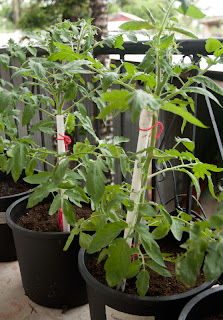 |
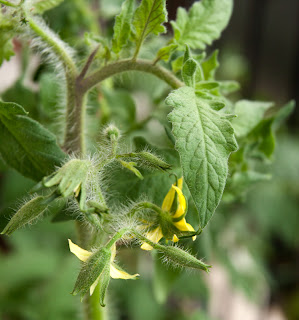 |
DAY 110 - DECLINING HEALTH & TERMINATION
These plants have looked promising throughout most of their development, but unfortunately the whiteflies have really taken their toll. The small number of flies present early on had little effect on the growth of the plants, but by the time all six tomato plants were full-grown, the whitefly population was out of control. Catastrophic leaf loss resulted. I kept the plants trimmed of dead leaves, but new leaves did not seem to develop to replace them. Furthermore, after a period of flowering in which all but one of the flowers either did not pollinate or dropped off when I attempted to vibrate them, all flowering ceased. Between the two plants one tomato began to develop but had a dark rotten spot at the bottom from the very beginning--a symptom of Blossom-End Rot. As the unhealthy plants were just drawing more whiteflies, I decided today to pull them up and dispose of them (along with all the other equally unhealthy tomato plants). It was a tough decision after all my work, but I don't think they were going to produce anything significant. I've already sowed some new seeds in starter pots to begin the process again (sigh).SECOND ATTEMPT
DAY 1 - NEW SEEDLING TRANSPLANTATION
Today I planted a new German Green plant that I started from seed about a month ago. The seedling was planted in a huge pig feed bag with a layer of gravel at the bottom and filled with potting soil. This bag will provide the plant about three times the growing space of the pots I used during my first tomato run. Hopefully, that will help. Additionally, whiteflies seem not to be present, and the plants are getting maximum sunshine in the garden shelter on the roof. Two Cherokee Purple plants fromthis same batch, however, came down with Tomato Yellow Leaf Curl Virus, so I'm hoping these are not also infected. The other plants did not show signs until about two weeks after transplantation.
DAY 21 (9/5) - GOOD PROGRESS / DISEASE-FREE
The German Green plant is doing as well, if not better, than the Black Krim plant next to it--both planted at the same time. No sign of disease and no whiteflies. It has grown from a small seedling to about 2 feet tall in a little over two weeks. Leaf growth is good and flower buds are already starting to develop near the top. The trunk is getting nice and thick. As I did with the Super Sweet 100VF and San Marzanos, I'll probably allow two trunks to develop.DAY 96 (11/20) - FIRST HARVEST
 Well, these plants have taken a long, long time to reach maturity. Or rather, the fruit has taken a long time. But I've finally got my first harvest! Three quite massive fruit have been picked and, man, were they delicious! The claims are true. German Green tomatoes have a special flavor--deep, rich, smokey. Delicious! What's interesting, though, is that my fruit didn't stay green as expected. Instead, they ended up a rich golden color. Will the plants continue to produce? I'm not so sure. It's getting late in the year and the sunny weather seems to have mostly subsided. There are still flowers on the plants, so we'll have to wait and see. I'm just stoked that I got a beefsteak tomato to produce at all on this island!
Well, these plants have taken a long, long time to reach maturity. Or rather, the fruit has taken a long time. But I've finally got my first harvest! Three quite massive fruit have been picked and, man, were they delicious! The claims are true. German Green tomatoes have a special flavor--deep, rich, smokey. Delicious! What's interesting, though, is that my fruit didn't stay green as expected. Instead, they ended up a rich golden color. Will the plants continue to produce? I'm not so sure. It's getting late in the year and the sunny weather seems to have mostly subsided. There are still flowers on the plants, so we'll have to wait and see. I'm just stoked that I got a beefsteak tomato to produce at all on this island!






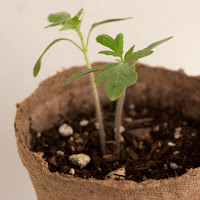
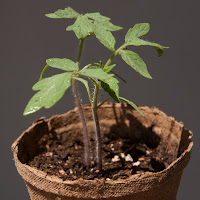


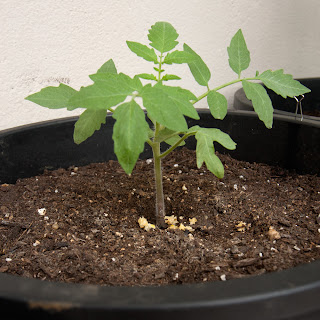
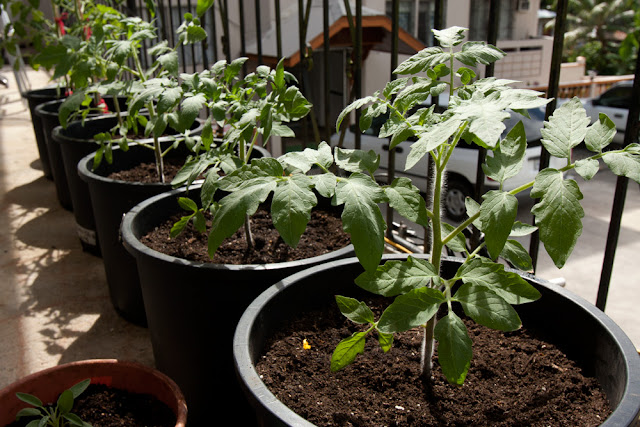





.jpg)







0 comments:
Post a Comment